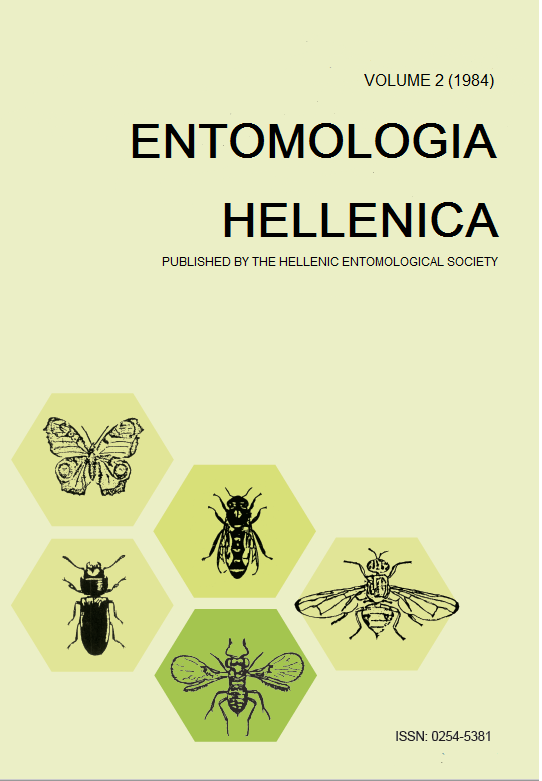Κίτρινο Παραλληλεπίπεδο με Κόλλα και Κάψουλα Οξεικού Αμμωνίου Βραδείας Απελευθέρωσης: μια Αποδοτική Μακριάς Διάρκειας Παγίδα για το Δάκο της Ελιάς
Περίληψη
Ο συνδυασμός κίτρινου παραλληλεπίπεδου (14x20 εκ.) με κόλλα και κάψουλα οξεικού αμμωνίου βραδείας απελευθέρωσης (ΚΟΑ) συγκρίθηκε με ίδια παγίδα χωρίς οξεικό αμμώνιο (Κ), καθώς και με παγίδες γυάλινες McPhail με προσελκυστικό Buminal (MB) ή Entomozyl (ΜΕ) ή θειική αμμωνία (ΜΘΑ) σε 2% διάλυμα νερού, από τις αρχές Αυγούστου μέχρι τις αρχές Δεκεμβρίου. Όταν συγκρίθηκαν οι συνολικές συλλήψεις δάκου ελιάς σε όλη την περίοδο, δεν βρέθηκαν μεγάλες διαφορές ανάμεσα στις παγίδες ΚΟΑ, MB και ΜΕ, ενώ οι παγίδες Κ και ΜΘΑ έπιασαν πολύ λιγότερα έντομα. Όταν οι συνολικές συλλήψεις εκφράστηκαν σαν λόγος κάθε παγίδας προς την παγίδα ΚΟΑ τότε η αποδοτικότητα των παγίδων ήταν: 1 (ΚΟΑ)-0,95 (ΜΒ)-0,7 (ΜΕ)-0,33 (Κ)-0,08 (ΜΘΑ). Το φθινόπωρο (μεγάλος δακοπληθυσμός), οι παγίδες ΚΟΑ και Κ έπιασαν πάρα πολλά έντομα ενώ οι παγίδες McPhail είχαν συγκριτικά μειωμένη απόδοση προφανώς λόγω χαμηλών θερμοκρασιών και υψηλής υγρασίας. Το αντίθετο συνέβη τον Αύγουστο-Σεπτέμβριο (θερμός-ξηρός καιρός, μικρός δακοπληθυσμός).
Οι παγίδες McPhail εφοδιάζοντο με φρέσκο διάλυμα προσελκυστικού κάθε περίπου μέρες το καλοκαίρι και 7 μέρες το φθινόπωρο. Οι κίτρινες παγίδες αντικαταστάθηκαν με καινούργιες μια φορά μόνο, στις αρχές Οκτωβρίου. Η κάψουλα οξεικού αμμωνίου μπορούσε να διαρκέσει πολύ περισσότερο (συνολικά περί τους 4 μήνες) αλλά οι επιφάνειες των παγίδων είχαν ήδη καλυφτεί με έντομα και άλλα αντικείμενα (φύλλα, κλαδάκια κ.λπ.).
Λεπτομέρειες άρθρου
- Πώς να δημιουργήσετε Αναφορές
-
Economopoulos Α., & Stavropoulou-Delivoria, A. (1984). Κίτρινο Παραλληλεπίπεδο με Κόλλα και Κάψουλα Οξεικού Αμμωνίου Βραδείας Απελευθέρωσης: μια Αποδοτική Μακριάς Διάρκειας Παγίδα για το Δάκο της Ελιάς. ENTOMOLOGIA HELLENICA, 2, 17–23. https://doi.org/10.12681/eh.13907
- Τεύχος
- Τόμ. 2 (1984)
- Ενότητα
- Articles

Αυτή η εργασία είναι αδειοδοτημένη υπό το CC Αναφορά Δημιουργού – Μη Εμπορική Χρήση – Παρόμοια Διανομή 4.0.
Authors who publish with this journal agree to the following terms:
Authors retain copyright and grant the journal right of first publication with the work simultaneously licensed under a Creative Commons 4.0 license.
Authors are able to enter into separate, additional contractual arrangements for the non-exclusive distribution of the journal's published version of the work (e.g. post it to an institutional repository or publish it in a book), with an acknowledgement of its initial publication in this journal. Authors are permitted and encouraged to post their work online (preferably in institutional repositories or on their website) prior to and during the submission process, as it can lead to productive exchanges, as well as earlier and greater citation of published work.



